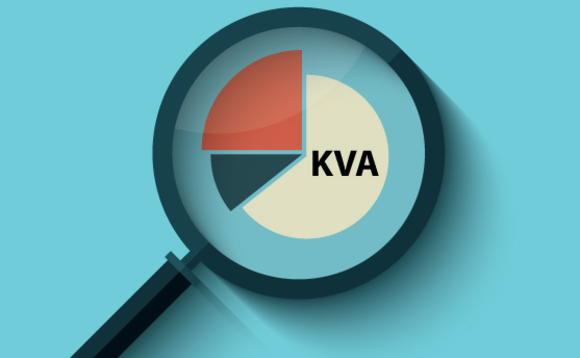
KVA pushes accounting standards to the limit
Radical changes may be needed if banks are to account for cost of capital in their derivatives trades
 The evidence that banks price the cost of capital into their derivatives trades is stacking up. Apart from being exhaustingly complex to understand, the capital valuation adjustment (KVA), which reflects the capital consumed by a trade over its lifetime, is also bank-specific. So the accounting argument that derivatives reported at fair value should have an exit price flies out of the window.
The evidence that banks price the cost of capital into their derivatives trades is stacking up. Apart from being exhaustingly complex to understand, the capital valuation adjustment (KVA), which reflects the capital consumed by a trade over its lifetime, is also bank-specific. So the accounting argument that derivatives reported at fair value should have an exit price flies out of the window.
If the KVA had been a small adjustment, banks could wait around for accounting standard setters and regulators to tell them what to do. But it isn't, and it is also expected to outgrow its older cousin, the funding valuation adjustment (FVA). It might even be years before supervisors start taking an active interest – the Basel Committee and the US Financial Accounting Standards Board only started looking at FVA recently. Naturally, the industry is impatient to get this sorted on its own.
In Accounting for KVA under IFRS 13, authors Chris Kenyon, a director in the credit valuation adjustment (CVA)/FVA quantitative research team at Lloyds Banking Group in London, and Richard Kenyon, a senior lecturer of accounting at Birmingham City University, argue that accounting standards' recommended techniques are not restricted to the use of an exit price, or the price another dealer is willing to pay to step in, in order to fair value a derivative.
Current accounting standards require banks to report their derivatives at fair value, which many have argued over the years should be based on the exit price. International Financial Reporting Standard (IFRS) 13 provides three ways to fair value an instrument: through market value; replacement cost; or based on the cashflows of the project, called the income approach. The standards also allow for a combination of the approaches – this is what makes the case for KVA accounting, according to the paper.
For instance, it seems fairly straightforward that the cost of capital reflects the opportunity cost of tying up a certain amount of capital to one trade, and hence forms part of payment cashflows under the income approach. The income-based approach can be seen in many derivatives models such as Black-Scholes, for example, where payoffs are discounted based on certain assumptions. As a result, international accounting standards allow marking to model in certain circumstances. So even in the absence of a market price, modelled KVA numbers can be included as part of the fair value of the trade.
The authors' solution for doing this centres around the valuation of derivatives based on the present value of all cashflows, including the cost of capital.
For instance, if an interest rate swap dealer considers the cost of capital as a discounted cashflow as part of the trade, its swap rate would reflect that,. When the counterparty pays the swap rate, the cost of capital is already factored into it and flows through earnings to be distributed to shareholders.
This even seems to curb what some call the Ponzi scheme-style practice of banks charging clients lifetime costs such as KVA upfront and then distributing the profits to shareholders in the first year, when it is clearly a cost that needs to be paid off periodically over the lifetime of the trade.
It all sounds ideal and straightforward, but it isn't.
One of the most popular assumptions in classical finance is that the market value of a firm does not depend on the way it is financed – dubbed the Modigliani-Miller theorem, after its originators. Getting any accounting framework that breaks this law to stick would require convincing a lot of stakeholders to abandon some of the most fundamental assumptions on which valuation is based. In recent years, banks have been fairly open to that; as for regulators and accountants, we won't know until they speak up.
Then there are competing accounting frameworks. Claudio Albanese, from consulting firm Global Valuation, for instance, is a proponent of applying Solvency II, a regulatory capital framework being implemented this year in the insurance industry, in the context of KVA accounting. This would be in line with IFRS 4 phase II, an accounting standard for insurance contracts.
Under Solvency II, risk margins – or the portion of capital coming from clients as opposed to shareholders – is considered as loss-absorbing capital rather than an adjustment to earnings which feeds through into capital, as is done in the case of CVA and FVA by most banks. Albanese argues KVA is the same as insurance risk margins, suggesting, in the context of derivatives, it be taken through retained earnings, where it counts as capital and is slowly released over the life of the trade.
This also takes care of the Ponzi scheme concerns voiced by dealers, since the KVA charged to clients at the start of the trade is retained on the balance sheet to be distributed at the right time.
What is evident from all of this is that both accounting views seem to call for radical changes – one involves breaking fundamental laws, and the other requires a major crossover from the insurance industry to the probably more complex derivatives business. Perhaps, that is just the kind of fix the industry needs.
Only users who have a paid subscription or are part of a corporate subscription are able to print or copy content.
To access these options, along with all other subscription benefits, please contact info@risk.net or view our subscription options here: http://subscriptions.risk.net/subscribe
You are currently unable to print this content. Please contact info@risk.net to find out more.
You are currently unable to copy this content. Please contact info@risk.net to find out more.
Copyright Infopro Digital Limited. All rights reserved.
You may share this content using our article tools. Printing this content is for the sole use of the Authorised User (named subscriber), as outlined in our terms and conditions - https://www.infopro-insight.com/terms-conditions/insight-subscriptions/
If you would like to purchase additional rights please email info@risk.net
Copyright Infopro Digital Limited. All rights reserved.
You may share this content using our article tools. Copying this content is for the sole use of the Authorised User (named subscriber), as outlined in our terms and conditions - https://www.infopro-insight.com/terms-conditions/insight-subscriptions/
If you would like to purchase additional rights please email info@risk.net
More on Markets
Credit determinations review proposes independent members
Isda AGM: Linklaters unveils key recommendations for CDS committee overhaul
Saudi Arabia poised to become clean netting jurisdiction
Isda AGM: Netting regulation awaiting final approvals from regulators
Buy side looks to fill talent gap in yen rates trading
Isda AGM: Japan rate rises spark demand for traders; dealers say inexperience could trigger volatility
JP Morgan’s new way to trade FX overlays
Hybrid execution method allows clients to put dealers in competition via a single trading agreement
Pension funds eye 30-year Bunds as swap spread tightens
Long-dated bonds continue to cheapen versus euro swaps, and some think they might fall further
Banks mull whether to stick or twist with SDPs
Fewer providers are going all-in on single-dealer platforms, which may lead to consolidation
Market for ‘orphan’ hedges leaves some borrowers stranded
Companies with private credit loans face punitive costs from banks for often imperfect hedges
Green knights? Banks step into struggling carbon credit markets
Clearer global standards and a new exchange may attract dealer entry, but supply and demand challenges remain
Most read
- Top 10 operational risks for 2024
- Japanese megabanks shun internal models as FRTB bites
- Filling gaps in market data with optimal transport







